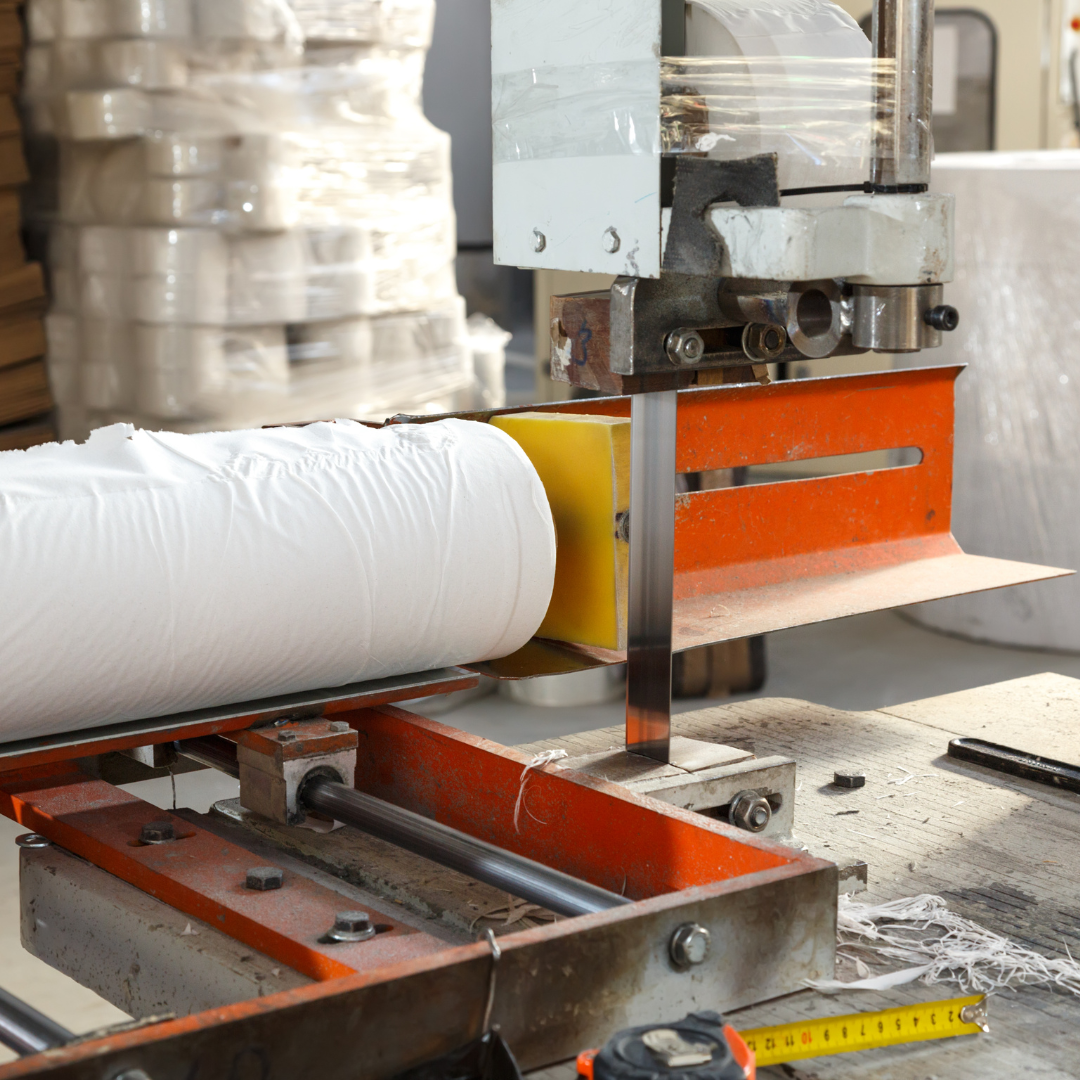According to the Environmental Protection Agency (EPA), paper and paperboard products make up the largest portion (25 percent) of municipal solid waste in the United States. The production of one ton of paper consumes approximately 17-20 trees and 10,000 gallons of water, according to the University of Southern Indiana.
The production of paper is a significant contributor to environmental degradation, particularly due to the large amount of resources and energy required. However, by implementing sustainable practices, paper manufacturers can reduce waste and maximize efficiency in their production processes.
Reducing waste and maximizing efficiency in paper production involves various strategies, such as implementing recycling programs, using sustainable materials, optimizing energy usage, and monitoring water usage. These strategies can help reduce the environmental impact of paper production while also improving the economic viability of the industry.
Recycling programs can help reduce the amount of paper waste going to landfills and save trees from being cut down. Using sustainable materials like recycled paper or bamboo can reduce the resources required to produce paper and be more cost-effective in the long run. Optimizing energy usage, such as using more efficient machinery, can help reduce energy consumption in paper production.
Monitoring water usage is also critical in reducing waste and maximizing efficiency in paper production. Water is a significant resource in paper production, and its conservation can help save costs while also reducing the environmental impact of the industry.
Overall, reducing waste and maximizing efficiency in paper production requires a commitment to sustainability and an investment in new technologies and practices. By taking steps to reduce their environmental impact, paper manufacturers can help protect the planet and create a more sustainable industry.
Reducing waste and maximizing efficiency in paper production involves implementing practices that minimize the use of resources such as energy, water, and raw materials, while increasing productivity and reducing environmental impact.
In this article, we will discuss some of the steps we can take to reduce waste and maximize efficiency
- Use Recycled Materials
- Implement Lean Manufacturing Practices
- Using Different Types of Recycling
- Improving Efficiency
- Minimizing Scrap
- Using Alternative Fibers
- Designing for Recyclability
- Process Optimization
- Energy Management
- Raw Material Selection
- Recycling
- Inventory Management
- Monitoring Water Usage
- Key Takeaways
- Related Articles
Use Recycled Materials
Using recycled materials in paper production is an effective way to reduce waste and minimize the impact of the industry on the environment. Recycled paper is made from waste paper products such as newspapers, magazines, and cardboard boxes, which are processed and turned into new paper products.
Here are some benefits of using recycled materials in paper production:
- Conservation of natural resources: Using recycled materials reduces the need for virgin materials such as trees, which conserves natural resources and preserves forests.
- Energy savings: The production of recycled paper uses less energy than the production of virgin paper, which reduces greenhouse gas emissions and lowers the industry's carbon footprint.
- Reduced water usage: The production of recycled paper uses less water than the production of virgin paper, which reduces the industry's impact on water resources.
- Reduced waste: Using recycled materials reduces the amount of waste generated, which reduces the need for landfill space and lowers disposal costs.
- Lower production costs: The use of recycled materials can result in cost savings for paper manufacturers, as recycled materials are often less expensive than virgin materials.
By using recycled materials, paper manufacturers can reduce their impact on the environment, conserve natural resources, and save on production costs. Consumers can also make a difference by choosing paper products made from recycled materials and recycling their own paper waste.
Implement Lean Manufacturing Practices
Implementing lean manufacturing practices is an effective way to reduce waste, increase efficiency, and improve productivity in paper production. Lean manufacturing is a systematic approach to identifying and eliminating waste in the production process, which includes activities that do not add value to the product.
Here are some examples of lean manufacturing practices that can be implemented in paper production:
- Just-in-time (JIT) production: JIT production is a method of producing goods in which each process is closely synchronized with the subsequent process to ensure that materials and products are available when needed. JIT production reduces inventory levels, minimizes waste, and improves efficiency.
- Kaizen: Kaizen is a continuous improvement process that involves identifying and eliminating waste in the production process. It focuses on making small, incremental changes to processes to improve efficiency and quality.
- Total Productive Maintenance (TPM): TPM is a maintenance approach that involves the entire workforce in maintaining and improving the production equipment to reduce downtime and increase efficiency.
- 5S methodology: 5S is a method for organizing and maintaining a clean and efficient workplace. It includes five steps: Sort, Set in Order, Shine, Standardize, and Sustain. 5S helps to reduce waste and increase productivity by creating a more organized and efficient workplace.
- Value Stream Mapping (VSM): VSM is a process mapping technique used to identify waste and improve processes. It involves mapping the flow of materials and information through the production process to identify areas for improvement.
By implementing lean manufacturing practices, paper manufacturers can reduce waste, increase efficiency, and improve productivity, which can result in cost savings and improved customer satisfaction.
Using Different Types of Recycling
Recycling is the process of converting waste materials into new products to prevent them from ending up in landfills, incinerators, or the natural environment. Recycling conserves natural resources, reduces energy consumption, and helps reduce pollution.
There are different types of recycling, including:
- Material recycling: This is the most common form of recycling and involves the conversion of waste materials, such as paper, plastics, glass, and metals, into new products.
- Organic recycling: This involves the composting of organic waste, such as food scraps and yard waste, to create nutrient-rich compost that can be used to fertilize plants and improve soil health.
- Electronic recycling: Also known as e-waste recycling, this involves the collection and processing of electronic waste, such as computers, cell phones, and televisions, to recover valuable materials and reduce the environmental impact of electronic waste.
Recycling can be done at home, in the workplace, or through municipal recycling programs. It is important to follow local recycling guidelines and properly sort recyclable materials to ensure they can be effectively processed and recycled. By recycling, individuals and organizations can help conserve natural resources, reduce waste, and protect the environment.
Improving Efficiency
Improving efficiency is the process of reducing waste, conserving resources, and increasing productivity in various industries, including manufacturing, energy, transportation, and agriculture. By improving efficiency, companies can reduce costs, increase profitability, and reduce their environmental impact.
Here are some ways to improve efficiency in different industries:
- Manufacturing: Manufacturing industries can improve efficiency by reducing material waste, implementing lean manufacturing techniques, and using energy-efficient equipment. Automation and digitization of the manufacturing process can also help improve efficiency.
- Energy: Energy efficiency can be improved by reducing energy consumption, using renewable energy sources, and implementing energy-efficient technologies, such as LED lighting and smart thermostats. Energy management systems can also help monitor and optimize energy use.
- Transportation: Transportation efficiency can be improved by using fuel-efficient vehicles, optimizing delivery routes, and reducing idle time. Alternative transportation modes, such as cycling and public transportation, can also help reduce transportation-related emissions.
- Agriculture: Agriculture industries can improve efficiency by optimizing water use, reducing fertilizer and pesticide use, and using precision agriculture techniques, such as GPS-guided equipment and drones. Implementing sustainable agriculture practices can also help reduce the environmental impact of agriculture.
Improving efficiency requires a commitment to continuous improvement and a willingness to invest in new technologies and practices. By improving efficiency, companies can reduce their environmental impact, increase profitability, and contribute to a more sustainable future.
Minimizing Scrap
Minimizing scrap is the process of reducing the amount of waste generated during the manufacturing or production process. By minimizing scrap, companies can reduce their environmental impact and increase efficiency, which can lead to cost savings and improved profitability.
Here are some ways to minimize scrap:
- Quality control: Implementing a robust quality control program can help reduce the amount of scrap generated during the production process. This includes identifying defects early in the process and implementing corrective actions to prevent them from occurring again.
- Process optimization: Optimizing the manufacturing or production process can help reduce scrap by improving efficiency and reducing waste. This can be achieved through process automation, equipment upgrades, and training employees on best practices.
- Raw material selection: Selecting high-quality raw materials can help reduce scrap by improving product quality and reducing the likelihood of defects. Using recycled or sustainable materials can also help reduce the environmental impact of production.
- Recycling: Recycling scrap materials can help reduce waste and conserve resources. Many companies have implemented recycling programs that collect and process scrap materials for reuse.
- Inventory management: Proper inventory management can help reduce scrap by preventing overproduction and ensuring that materials are used efficiently. This can be achieved through better forecasting, just-in-time delivery, and inventory tracking systems.
By minimizing scrap, companies can reduce their environmental impact, increase efficiency, and improve profitability. It requires a commitment to continuous improvement and a willingness to invest in new technologies and practices.
Using Alternative Fibers
Using alternative fibers is a strategy to reduce the environmental impact of traditional paper production, which typically relies on virgin wood pulp. Alternative fibers are derived from non-wood sources, such as agricultural waste, recycled textiles, and grasses.
Here are some benefits of using alternative fibers:
- Conservation of natural resources: Using alternative fibers reduces the demand for virgin wood pulp, which conserves natural resources and reduces the impact of deforestation.
- Reduced energy consumption: Alternative fibers require less energy to produce than traditional wood-based pulp, which reduces the environmental impact of paper production.
- Reduced waste: Using alternative fibers can reduce waste by using materials that would otherwise be discarded, such as agricultural waste.
- Improved sustainability: Using alternative fibers can improve the sustainability of the paper production process by reducing the environmental impact and conserving natural resources.
- Increased versatility: Alternative fibers can be used in a variety of paper products, including packaging, tissue, and printing paper, which increases the versatility of paper production.
Some examples of alternative fibers include hemp, bamboo, bagasse (sugarcane waste), and cotton linters. These fibers can be processed using similar techniques to traditional wood-based pulp and can be used to produce high-quality paper products.
By using alternative fibers, paper producers can reduce their environmental impact, improve sustainability, and conserve natural resources.
Designing for Recyclability
Designing for recyclability is the process of creating products that can be easily and effectively recycled at the end of their useful life. By designing products for recyclability, manufacturers can reduce waste, conserve resources, and improve the sustainability of their products.
Here are some ways to design for recyclability:
- Material selection: Choosing materials that are easily recyclable, such as aluminum, steel, and PET plastic, can make it easier to recycle products at the end of their useful life.
- Simplified designs: Simplified designs with fewer components and materials can make it easier to recycle products by reducing the complexity of the recycling process.
- Labeling: Clear labeling with recycling symbols and instructions can help consumers properly sort and recycle products.
- Disassembly: Designing products for easy disassembly can make it easier to separate materials for recycling and reduce the amount of waste generated during the recycling process.
- Reusability: Designing products for reusability can reduce waste and extend the life of products, reducing the need for recycling.
Designing for recyclability requires a commitment to sustainability and a willingness to invest in new technologies and practices. By designing products for recyclability, manufacturers can reduce waste, conserve resources, and improve the sustainability of their products, contributing to a more sustainable future.
Process Optimization
Process optimization is the practice of identifying and eliminating inefficiencies in a production process to improve productivity, reduce waste, and increase profitability. In the context of paper production, process optimization involves analyzing the various steps involved in paper manufacturing and identifying areas where improvements can be made to increase efficiency and reduce waste.
Here are some ways to optimize the paper production process:
- Data collection and analysis: Collecting and analyzing data on the production process can help identify areas for improvement. Data can be collected using sensors, meters, and other monitoring devices, and then analyzed using statistical methods to identify patterns and trends.
- Process automation: Automating certain aspects of the production process, such as material handling and quality control, can help reduce waste and increase efficiency. Automation can also improve safety by reducing the need for manual labor.
- Equipment upgrades: Upgrading equipment with more energy-efficient or technologically advanced models can improve efficiency and reduce waste. For example, using high-speed machines that consume less energy can increase productivity while reducing the amount of waste generated.
- Employee training: Providing training to employees on best practices and the latest technologies can improve the efficiency of the production process. Training can help employees identify and address inefficiencies and reduce the amount of waste generated.
- Continuous improvement: Implementing a continuous improvement program that encourages employees to identify and address inefficiencies in the production process can help improve efficiency and reduce waste over time.
By optimizing the paper production process, producers can reduce their environmental impact, increase productivity, and improve profitability. It requires a commitment to continuous improvement and a willingness to invest in new technologies and practices.
Energy Management
Energy management in paper production is the process of reducing energy consumption, improving energy efficiency, and utilizing renewable energy sources to reduce the environmental impact of paper manufacturing. Efficient energy management can reduce greenhouse gas emissions, lower energy costs, and improve the sustainability of the production process.
Here are some ways to improve energy management in paper production:
- Energy-efficient equipment: Using energy-efficient equipment can reduce energy consumption and greenhouse gas emissions. Examples include high-efficiency motors, pumps, and fans, as well as LED lighting.
- Process optimization: Optimizing the production process can reduce energy consumption by eliminating inefficiencies and reducing waste. This can be achieved through process automation, equipment upgrades, and employee training.
- Renewable energy sources: Using renewable energy sources, such as solar or wind power, can reduce greenhouse gas emissions and lower energy costs. Many paper producers have installed renewable energy systems on-site to reduce their reliance on fossil fuels.
- Energy audits: Conducting regular energy audits can help identify areas where energy is being wasted and opportunities to improve energy efficiency. Energy audits can also help identify potential savings and ROI for energy management investments.
- Energy management systems: Implementing energy management systems can help monitor and control energy usage, identify areas for improvement, and track energy savings over time.
By improving energy management in paper production, producers can reduce their environmental impact, improve sustainability, and lower energy costs. It requires a commitment to continuous improvement and a willingness to invest in new technologies and practices.
Raw Material Selection
Raw material selection is an important consideration in paper production. The quality of the raw materials used can have a significant impact on the quality of the finished product, as well as the environmental impact of the production process. Choosing high-quality raw materials and using sustainable or recycled materials can help reduce waste and improve the sustainability of the production process.
Here are some ways to improve raw material selection in paper production:
- Selecting high-quality raw materials: Choosing high-quality raw materials can improve the quality of the finished product and reduce the amount of waste generated during production. It is important to work with suppliers who can provide consistent quality materials and have good environmental and social practices.
- Sustainable forestry practices: Sourcing wood pulp from sustainably managed forests can help ensure a steady supply of raw materials while also protecting natural habitats and biodiversity. Many paper producers have implemented sustainable forestry practices and have obtained certifications such as Forest Stewardship Council (FSC) or Programme for the Endorsement of Forest Certification (PEFC).
- Recycled materials: Using recycled materials, such as waste paper, can help reduce the amount of waste generated during production and conserve resources. Many paper producers have implemented recycling programs to collect and process waste paper for reuse.
- Alternative fibers: Using alternative fibers, such as bamboo or agricultural residues, can provide a sustainable and renewable source of raw materials. Alternative fibers can also provide unique properties to the finished product.
- Material efficiency: Improving material efficiency by reducing the amount of raw materials used in production can help conserve resources and reduce waste. This can be achieved through process optimization, material substitution, and product design changes.
By improving raw material selection in paper production, producers can improve the sustainability of the production process and reduce their environmental impact. It requires a commitment to continuous improvement and a willingness to invest in new technologies and practices.
Recycling
Recycling is an important aspect of paper production, as it can help conserve natural resources and reduce the environmental impact of the production process. Recycling involves collecting used paper products and processing them to create new paper products. The recycling process can help reduce the amount of waste generated and reduce the need for virgin wood pulp, which can help conserve natural resources.
Here are some ways to improve recycling in paper production:
- Collection and sorting: Implementing effective collection and sorting systems can help ensure that paper waste is collected and processed efficiently. It is important to ensure that the collected waste is of high quality and free from contaminants.
- Processing: Processing the collected waste into new paper products requires specialized equipment and processes. It is important to ensure that the processing is done efficiently and effectively, with minimal waste and energy consumption.
- Using recycled content: Using recycled content in paper products can help reduce the demand for virgin wood pulp and conserve natural resources. Many paper producers have implemented programs to increase the amount of recycled content in their products.
- Education and awareness: Educating consumers and employees about the importance of recycling and the benefits of using recycled paper products can help increase demand for recycled products and improve recycling rates.
- Collaboration: Collaborating with other stakeholders, such as government agencies and recycling organizations, can help improve recycling infrastructure and increase the efficiency of the recycling process.
By improving recycling in paper production, producers can reduce their environmental impact, conserve natural resources, and improve the sustainability of the production process. It requires a commitment to continuous improvement and a willingness to invest in new technologies and practices.
Inventory Management
Inventory management is an important aspect of paper production, as it can help ensure that the right amount of raw materials and finished products are available at the right time, while minimizing waste and storage costs. Effective inventory management can help improve efficiency, reduce costs, and improve sustainability.
Here are some ways to improve inventory management in paper production:
- Forecasting: Accurate forecasting of demand can help ensure that the right amount of raw materials and finished products are available when needed, while minimizing the risk of excess inventory or stockouts.
- Lean manufacturing: Implementing lean manufacturing principles can help reduce inventory levels by minimizing waste and reducing lead times. This can be achieved through process optimization, improved scheduling, and reduced setup times.
- Just-in-time inventory: Implementing a just-in-time (JIT) inventory system can help reduce inventory levels by ensuring that materials and products are delivered just in time for production or delivery. JIT can help reduce waste and storage costs, while improving efficiency.
- Technology: Implementing inventory management software and other technologies can help improve inventory tracking and management, while reducing the risk of errors and improving efficiency.
- Supplier relationships: Building strong relationships with suppliers can help ensure reliable and timely delivery of raw materials and reduce the risk of stockouts. This can help minimize the need for excess inventory and improve efficiency.
By improving inventory management in paper production, producers can improve efficiency, reduce costs, and improve sustainability. It requires a commitment to continuous improvement and a willingness to invest in new technologies and practices.
Monitoring Water Usage
Monitoring water usage is a critical aspect of reducing waste and maximizing efficiency in paper production. Here are some ways to do it:
- Water meters: Installing water meters can help monitor and measure the amount of water used in different processes. This can help identify areas where water is being wasted and allow for better management of water resources.
- Water audits: Conducting regular water audits can help identify opportunities for water conservation and efficiency improvements. This involves analyzing water usage patterns and identifying areas where water can be conserved or reused.
- Process optimization: Optimizing the paper production process can help reduce water usage. For example, implementing closed-loop systems that recycle water can significantly reduce the amount of water needed in the production process.
- Water-efficient equipment: Choosing water-efficient equipment can also help reduce water usage. This includes selecting equipment with low-flow water nozzles and optimizing the use of water in the production process.
- Employee training: Training employees on water conservation best practices can help reduce water waste. This can include simple actions such as turning off faucets when not in use and reporting leaks and other issues promptly.
- Water-saving technologies: New technologies such as air flotation systems and vacuum-assisted dewatering can help reduce the amount of water needed in paper production.
Overall, monitoring water usage is critical to reducing waste and maximizing efficiency in paper production. By identifying areas where water can be conserved and implementing best practices and new technologies, paper manufacturers can reduce their environmental impact and save on costs.
Key Takeaways
Here's a summary of reducing waste and maximizing efficiency in paper production in bullet points:
- Implement recycling programs to reduce paper waste going to landfills and save trees.
- Use sustainable materials like recycled paper or bamboo to reduce resource consumption.
- Optimize energy usage by using more efficient machinery.
- Monitor water usage and implement water conservation practices to save costs and reduce environmental impact.
- Implement lean manufacturing principles to reduce waste and increase efficiency.
- Invest in new technologies like air flotation systems and vacuum-assisted dewatering to reduce water consumption.
Overall, reducing waste and maximizing efficiency in paper production requires a commitment to sustainability and an investment in new technologies and practices to create a more sustainable industry.
Related Articles











